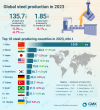- Joined
- Aug 20, 2022
- Messages
- 1,460
Counterfeiters are the biggest enemy and threat to the industry. Both corporate and custom makers have to contend with this variable.Something I alluded to in another thread recently, there are many many factors that impact whether a business is successful or not. You have supply and demand forces, macro economics, industry specific trends and changes, international influences, inflationary pressures, etc.
To run a successful business and keep it going for the long term requires staying in a good place in the supply and demand curve (which by the way are almost completely out of a companies control) and being able to be efficient enough to hold off competition while still maintaining a sustainable level of profitability. As we find more and more companies making steels, materials, knives, etc. eventually supply and demand kick in and only the most efficient companies who can manage to stay competitive and manage their businesses well, or have some competitive advantage over others will make it long term. Again, not to say that Crucible was mismanaged or inefficient, but keeping a business viable also requires a great deal of luck due to the many factors that are beyond an individual company's control.
People wanting things for cheap outnumber those of us who will pay for quality.




